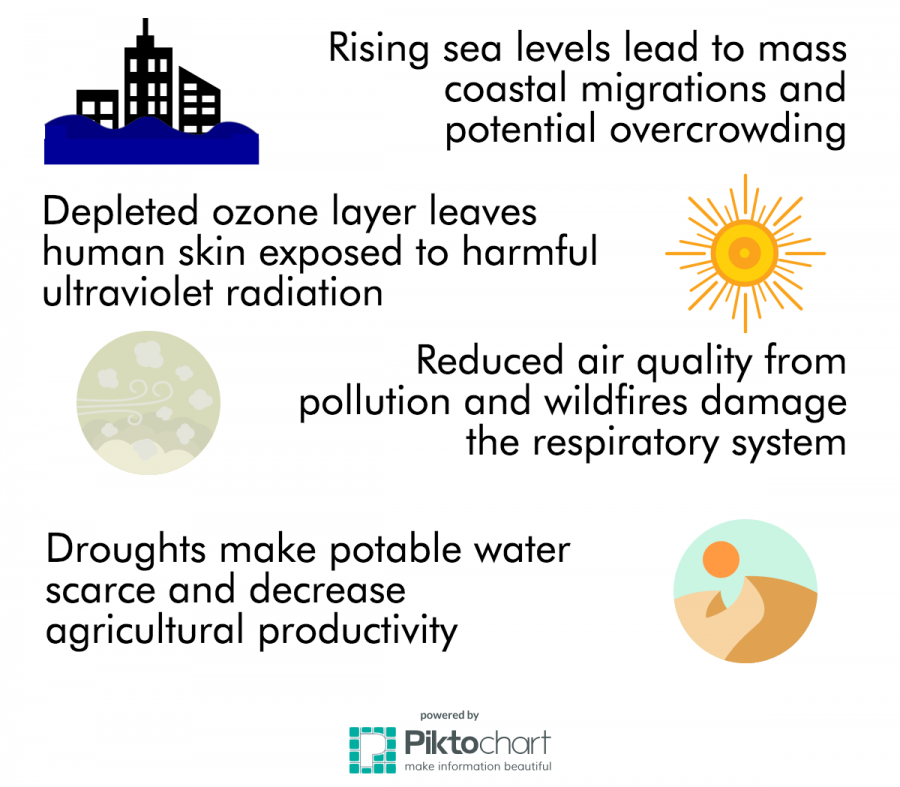The health effects of climate change
March 3, 2016
Increases in global temperatures, changes in humidity and rainfall patterns enable certain insects, such as ticks and mosquitoes, to populate regions previously uninhabitable by these organisms. These factors have increased the risk of human infection with certain diseases. West Nile virus, a disease first introduced to the United States in 1999, had over 16,000 cases reported by 2005, according to the National Resources Defense Council.
John Nielsen-Gammon, the Texas State Climatologist and Professor of Meteorology at Texas A&M University, describes the effects of rising temperatures on Earth and the possible spread of diseases.
“Because climate change is fairly gradual, to some extent, it is possible for people to acclimate to different climates; many countries in Europe have air conditioning, so they can always tolerate higher temperatures,” Nielsen-Gammom said. “There is a potential impact in terms of the spread of diseases, because changes in climate causes certain disease-carrying organisms, such as mosquitoes, to thrive.”
One of the main contributors to increasing temperatures on Earth is gas emissions. Such gases, which include carbon dioxide, methane and water vapor, prevent heat directed towards Earth from the sun from escaping.
This trapping of warmth, also known as the greenhouse effect, leads to increased concentrations of ground level ozone. Aeroallergens such as pollen and dust become more allergenic as temperatures and carbon dioxide levels rise. Both of these factors worsen air quality and leave individuals susceptible to lung-related diseases.
The risk of prolonged heat exposure may also become an important issue for humans as they face difficulties in maintaining a healthy body temperature and combating heat exhaustion and dehydration. According to the National Institute of Environmental Health Sciences, the percentage of individuals 65 years of age or older who will be affected by a heat-related disease will rise from 12.4% in 2000 to 20% in 2060.
Another effect of climate change, the depletion of Earth’s ozone layer, results from the release of certain chemicals into the atmosphere. According to the United States Environmental Protection Agency, the chemicals chlorine and bromine, common byproducts of human activity involving greenhouse gases, react with the oxygen atoms in the atmosphere and erode the ozone layer.
Upper school chemistry teacher Andrew Irvine discusses the possible outcomes of ozone layer depletion on human skin.
“What I understand is that the ozone layer helps filter ultraviolet light, or ultraviolet electromagnetic radiation, from reaching the surface of our planet,” Irvine said. “From that assumption, the increased results would be more sunburns and potential damage to the skin’s DNA, which would result in more skin cancer.”
The Earth’s ozone layer sits about nine to 18 miles above the surface of the planet and protects humans from the sun’s ultraviolet B radiation. The weakening of this barrier results in a possible increase of radiation reaching Earth, which inhibits the reproductive cycles of algae. According to National Geographic, this decrease in phytoplankton populations in turn impacts the populations of other animals.
To combat the various health effects of climate change, the United States Environmental Protection Agency recommends spending less time outdoors, wearing sunscreen and hats to protect the skin and avoiding places with high concentrations of small particles and aeroallergens.


















![“[Building nerf blasters] became this outlet of creativity for me that hasn't been matched by anything else. The process [of] making a build complete to your desire is such a painstakingly difficult process, but I've had to learn from [the skills needed from] soldering to proper painting. There's so many different options for everything, if you think about it, it exists. The best part is [that] if it doesn't exist, you can build it yourself," Ishaan Parate said.](https://harkeraquila.com/wp-content/uploads/2022/08/DSC_8149-900x604.jpg)




![“When I came into high school, I was ready to be a follower. But DECA was a game changer for me. It helped me overcome my fear of public speaking, and it's played such a major role in who I've become today. To be able to successfully lead a chapter of 150 students, an officer team and be one of the upperclassmen I once really admired is something I'm [really] proud of,” Anvitha Tummala ('21) said.](https://harkeraquila.com/wp-content/uploads/2021/07/Screen-Shot-2021-07-25-at-9.50.05-AM-900x594.png)







![“I think getting up in the morning and having a sense of purpose [is exciting]. I think without a certain amount of drive, life is kind of obsolete and mundane, and I think having that every single day is what makes each day unique and kind of makes life exciting,” Neymika Jain (12) said.](https://harkeraquila.com/wp-content/uploads/2017/06/Screen-Shot-2017-06-03-at-4.54.16-PM.png)








![“My slogan is ‘slow feet, don’t eat, and I’m hungry.’ You need to run fast to get where you are–you aren't going to get those championships if you aren't fast,” Angel Cervantes (12) said. “I want to do well in school on my tests and in track and win championships for my team. I live by that, [and] I can do that anywhere: in the classroom or on the field.”](https://harkeraquila.com/wp-content/uploads/2018/06/DSC5146-900x601.jpg)
![“[Volleyball has] taught me how to fall correctly, and another thing it taught is that you don’t have to be the best at something to be good at it. If you just hit the ball in a smart way, then it still scores points and you’re good at it. You could be a background player and still make a much bigger impact on the team than you would think,” Anya Gert (’20) said.](https://harkeraquila.com/wp-content/uploads/2020/06/AnnaGert_JinTuan_HoHPhotoEdited-600x900.jpeg)

![“I'm not nearly there yet, but [my confidence has] definitely been getting better since I was pretty shy and timid coming into Harker my freshman year. I know that there's a lot of people that are really confident in what they do, and I really admire them. Everyone's so driven and that has really pushed me to kind of try to find my own place in high school and be more confident,” Alyssa Huang (’20) said.](https://harkeraquila.com/wp-content/uploads/2020/06/AlyssaHuang_EmilyChen_HoHPhoto-900x749.jpeg)






